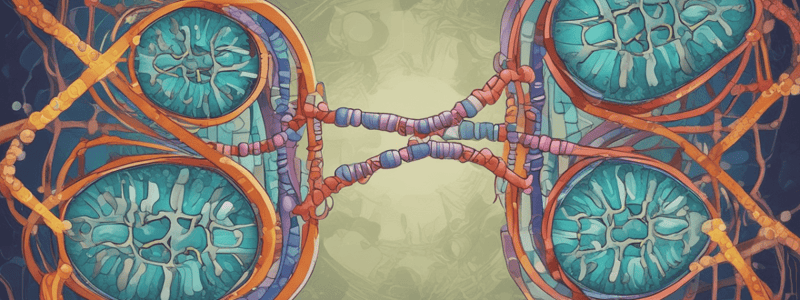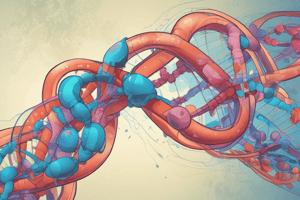Podcast
Questions and Answers
What is the function of poly(A) polymerase in eukaryotic transcription?
What is the function of poly(A) polymerase in eukaryotic transcription?
- To excise intron sequences from RNA transcripts
- To add 7-methyl guanosine caps to 5' termini
- To add poly(A) tails to 3' ends of RNA transcripts (correct)
- To edit RNA sequences prior to translation
What is the primary mechanism by which eukaryotic RNA polymerases catalyze RNA chain elongation?
What is the primary mechanism by which eukaryotic RNA polymerases catalyze RNA chain elongation?
- By the excision of intron sequences
- Through the addition of poly(A) tails
- By the same mechanism as prokaryotic RNA polymerases (correct)
- Through a mechanism unique to eukaryotes
What is the term for the process of adding poly(A) tails to eukaryotic mRNAs?
What is the term for the process of adding poly(A) tails to eukaryotic mRNAs?
- Polyadenylation (correct)
- RNA editing
- Transcription termination
- Exon splicing
What is the term for the process of changing the nucleotide sequences of eukaryotic transcripts prior to translation?
What is the term for the process of changing the nucleotide sequences of eukaryotic transcripts prior to translation?
What are noncoding sequences that interrupt the coding sequences of eukaryotic genes called?
What are noncoding sequences that interrupt the coding sequences of eukaryotic genes called?
What is the name given to the sequences that remain present in mature mRNA molecules?
What is the name given to the sequences that remain present in mature mRNA molecules?
What is the purpose of precise splicing in genes that encode proteins?
What is the purpose of precise splicing in genes that encode proteins?
What is the range of size of introns in terms of nucleotide pairs?
What is the range of size of introns in terms of nucleotide pairs?
What is the result of mutations at splicing sites in some cases?
What is the result of mutations at splicing sites in some cases?
How are introns in some rRNA precursors removed?
How are introns in some rRNA precursors removed?
What is the role of introns in regulating gene expression?
What is the role of introns in regulating gene expression?
What is the benefit of introns in increasing the rate of evolution?
What is the benefit of introns in increasing the rate of evolution?
What is the purpose of specific codons in the genetic code?
What is the purpose of specific codons in the genetic code?
What is the significance of the universality of the genetic code?
What is the significance of the universality of the genetic code?
What is the difference between primary transcripts in prokaryotes and eukaryotes?
What is the difference between primary transcripts in prokaryotes and eukaryotes?
What is the purpose of splicing reactions in eukaryotic gene expression?
What is the purpose of splicing reactions in eukaryotic gene expression?
What is the central dogma of molecular biology?
What is the central dogma of molecular biology?
What is the role of messenger RNA (mRNA) in gene expression?
What is the role of messenger RNA (mRNA) in gene expression?
What is the purpose of the 5' cap and 3' poly(A) tail in eukaryotic mRNA?
What is the purpose of the 5' cap and 3' poly(A) tail in eukaryotic mRNA?
What is the difference between exons and introns in eukaryotic genes?
What is the difference between exons and introns in eukaryotic genes?
Flashcards are hidden until you start studying
Study Notes
Interrupted Genes in Eukaryotes: Exons and Introns
- Eukaryotic genes contain noncoding sequences called introns that interrupt the coding sequences, or exons.
- Introns are excised from RNA transcripts prior to their transport to the cytoplasm.
- Noncoding sequences intervening between coding sequences are called introns (for intervening sequences).
- The sequences that remain present in mature mRNA molecules (both coding and noncoding sequences) are called exons (for expressed sequences).
Properties of Introns
- Introns vary in size, ranging from about 50 nucleotide pairs to thousands of nucleotide pairs in length.
- Some introns contain sequences that can regulate gene expression in either a positive or negative fashion.
- Introns may provide a selective advantage by increasing the rate at which coding sequences in different exons of a gene can reassort by recombination, thus speeding up the process of evolution.
Removal of Intron Sequences by RNA Splicing
- The noncoding introns are excised from gene transcripts by several different mechanisms.
- The splicing mechanism must be precise; it must join exon sequences with accuracy to the single nucleotide to assure that codons in exons distal to introns are read correctly.
- Splicing and intron sequences can influence gene expression.
- Mutations at these sites are sometimes responsible for inherited diseases in humans, such as hemoglobin disorders.
Three Types of Intron Excision
- The introns of tRNA precursors are excised by precise endonucleolytic cleavage and ligation reactions catalyzed by special splicing endonuclease and ligase activities.
- The introns of some rRNA precursors are removed autocatalytically in a unique reaction mediated by the RNA molecule itself.
- RNA chain elongation and the addition of 5-methyl guanosine caps occur by the same mechanism as the RNA polymerases of prokaryotes.
Termination by Chain Cleavage and the Addition of 3 Poly(A) Tails
- The 3’ ends of RNA transcripts synthesized by RNA polymerase II are produced by endonucleolytic cleavage of the primary transcripts rather than by the termination of transcription.
- After cleavage, the enzyme poly(A) polymerase adds poly(A) tails, tracts of adenosine monophosphate residues about 200 nucleotides long, to the 3’ ends of the transcripts.
Key Points
- Three to five different RNA polymerases are present in eukaryotes, and each polymerase transcribes a distinct set of genes.
- Eukaryotic gene transcripts usually undergo three major modifications: (1) the addition of 7-methyl guanosine caps to 5’ termini, (2) the addition of poly(A) tails to 3’ ends, and (3) the excision of noncoding intron sequences.
- The information content of some eukaryotic transcripts is altered by RNA editing, which changes the nucleotide sequences of transcripts prior to their translation.
Studying That Suits You
Use AI to generate personalized quizzes and flashcards to suit your learning preferences.




